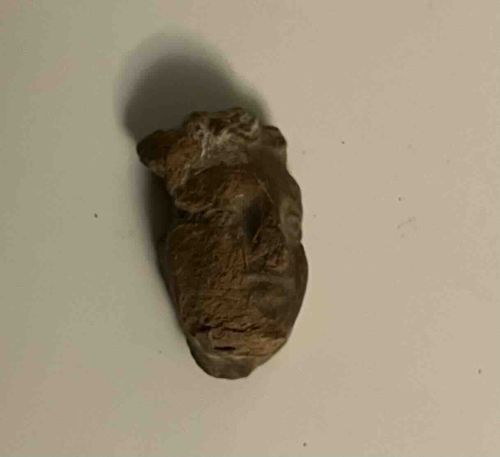
Fossilized Bivalve Mollusk
The item appears to be a fossilized mollusk, specifically resembling a bivalve, roughly 1 inch in length and 0.5 inches in width, though precise measurements are difficult without a scale indicator. Its color is a muted brown, indicative of sedimentary rock or fossilized organic material. The texture is rough and irregular, consistent with natural degradation and mineralization over time. There are visible striations and contours on its surface, which could represent growth lines or the natural external morphology of the original organism. The overall shape is irregular and somewhat elongated, with a thicker, more rounded top portion tapering towards a narrower base. There are no discernible maker's marks, signatures, or stamps, as would be expected for a natural specimen. The condition exhibits natural wear and erosion, with some areas appearing more fragmented or chipped, particularly towards the bottom. The details of the original shell structure are somewhat obscured by the fossilization process and surface wear, but the general form of a bivalve is still recognizable. The item appears to be a natural fossil rather than a manufactured object, suggesting a geological age, likely millions of years old. The craftsmanship is naturally occurring.
AI-Generated Appraisal Disclaimer
Estimated Value
$10-25
Basic Information
Category
Natural History Specimen
Appraised On
November 30, 2025
Estimated Value
$10-25
Additional Details Provided By Owner
User Provided Information
Approximately 1 in x 1/2 in
Item Description
The item appears to be a fossilized mollusk, specifically resembling a bivalve, roughly 1 inch in length and 0.5 inches in width, though precise measurements are difficult without a scale indicator. Its color is a muted brown, indicative of sedimentary rock or fossilized organic material. The texture is rough and irregular, consistent with natural degradation and mineralization over time. There are visible striations and contours on its surface, which could represent growth lines or the natural external morphology of the original organism. The overall shape is irregular and somewhat elongated, with a thicker, more rounded top portion tapering towards a narrower base. There are no discernible maker's marks, signatures, or stamps, as would be expected for a natural specimen. The condition exhibits natural wear and erosion, with some areas appearing more fragmented or chipped, particularly towards the bottom. The details of the original shell structure are somewhat obscured by the fossilization process and surface wear, but the general form of a bivalve is still recognizable. The item appears to be a natural fossil rather than a manufactured object, suggesting a geological age, likely millions of years old. The craftsmanship is naturally occurring.
Related Tags
Get Your Items Appraised
Instant estimates of your treasures with AI-powered instant appraisals